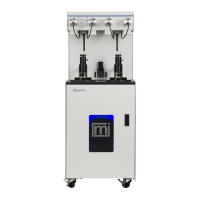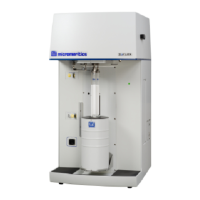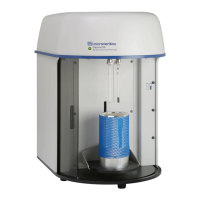ASPHALT DENSITY APPLICATION
The AccuPyc II TEC Module can measure asphalt density using disposable cups to limit cross-
contamination of samples. To show cup properties and asphalt options, go to Options >Option
Presentation and enable Show Cup Properties and Show Asphalt Options.
This solution can be closely correlated (< 0.15% difference) to results obtained with ASTM Test
Method D70-09. The AccuPyc asphalt density measurement is completed much faster than the
ASTM method while virtually eliminating operator error. The Peltier thermoelectric cooling control
(15 to 36 °C) provides stability for handling of samples.
ABOUT THE FOAMPYC MODULE
AFoamPyc option for measuring open and closed cell foam materials is available for both standard
and temperature-controlled pycnometers. This unit can be ordered initially with the FoamPyc
application installed, or can be upgraded from the standard AccuPyc with a software enhancement
via USBmedia. Configuration options are:
n 100 cm
3
nominal cell volume (recommended)
n 10 cm
3
nominal cell volume
The FoamPyc option performs analyses on materials such as polystyrene, urethane, and rubber
foams using five different methods:
n Correction using cell dimensions. Measures the closed cell fraction and corrects for the cells
damaged while cutting the sample to the necessary size and shape. This is accomplished by
using either the average cell diameter or the cell chord length (as defined in ASTM method
D-6226-15) and the measurements of the sample to determine the volume of the cut cells. This
volume is deducted from the total volume of the open cells measured by the pycnometer.
n Correction by recutting sample. Corrects for the cut cells by using two separate meas-
urements. For the 2nd measurement, the sample is recut to double the amount of cut surface.
The observed difference in cut open cell volume is applied as a correction to the initial measured
volume. This method offers the distinct advantage that no assumptions are needed about the rel-
ative amounts of open and closed cells.
n No correction. Does not correct for cut cells. It is used for materials with predominantly open
cells where good accuracy can be achieved without correction. The accuracy level deteriorates as
the percentage of closed cells increases.
n Compressibility test. The fill pressure is increased incrementally over the sample with each
repeat of the P1, P2 cycle (where P1 is the initial pressure to which the sample is charged, and P2
the final pressure after expansion). The apparent variation of the measured sample volume with
the average pressure is determined. This test is an approximate indication. It is not intended to be
an exact measure of the volume compressibility.
n Cell fracture test. A perfectly rigid foam is assumed. First, a P1, P2 cycle is performed at the
lower of two specified P1 pressures, and the results stored. A second cycle is performed at a
Asphalt Density Application
AccuPyc II 1345 Operator Manual
134-42851-01 (Rev A) — Jan 2021
1 - 5
